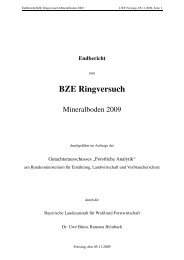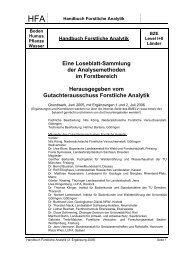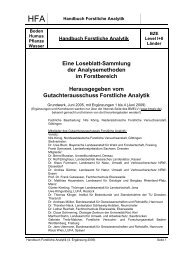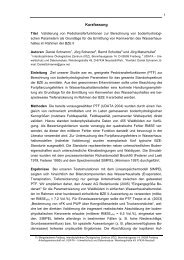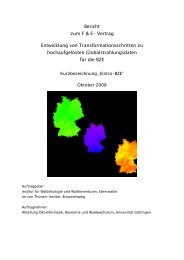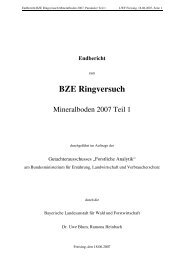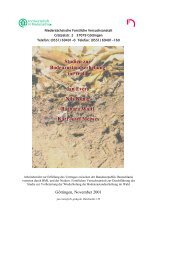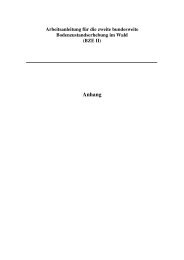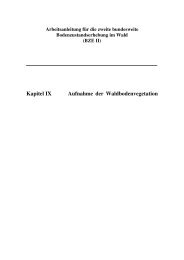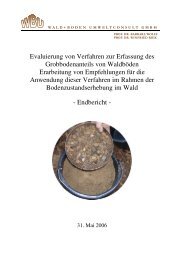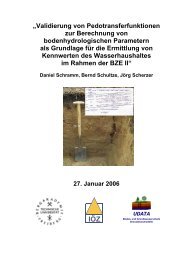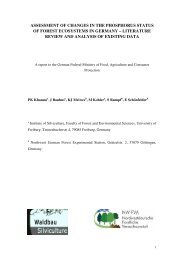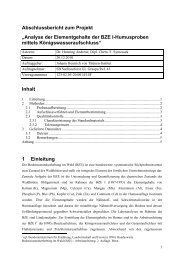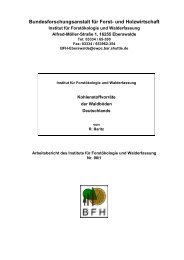assessment of changes in the phosphorus status of forest ...
assessment of changes in the phosphorus status of forest ...
assessment of changes in the phosphorus status of forest ...
Create successful ePaper yourself
Turn your PDF publications into a flip-book with our unique Google optimized e-Paper software.
usually present <strong>in</strong> <strong>the</strong> leaves. In very old stands, woody components may have<br />
accumulated <strong>the</strong> highest amount <strong>of</strong> P among all <strong>the</strong> o<strong>the</strong>r tree components. The annual<br />
accumulation <strong>of</strong> P was highest <strong>in</strong> needles and liv<strong>in</strong>g branches <strong>of</strong> spruce after<br />
application <strong>of</strong> P <strong>in</strong> fertilizer (Nielsen and Wiklund 1995).<br />
Given <strong>the</strong> function <strong>of</strong> P <strong>in</strong> leaves and needles and <strong>the</strong> importance <strong>of</strong> foliage as a P<br />
reservoir <strong>in</strong> <strong>forest</strong> ecosystems, <strong>the</strong> use <strong>of</strong> Critical Ranges <strong>of</strong> P concentrations <strong>in</strong> <strong>the</strong><br />
foliage is <strong>the</strong> most commonly used method <strong>of</strong> assess<strong>in</strong>g <strong>the</strong> P <strong>status</strong> <strong>of</strong> <strong>forest</strong> trees.<br />
However, <strong>the</strong>re are many limitations to its use. The most important one is that <strong>the</strong><br />
critical range values do not represent a unique P state <strong>of</strong> plants but vary significantly<br />
among tree species, tree age, foliage age, seasons, and are <strong>in</strong>fluenced by water or<br />
o<strong>the</strong>r stresses and many o<strong>the</strong>r site (chemical and biological processes) and plant<br />
factors (retranslocation, o<strong>the</strong>r nutrient levels). In addition, <strong>the</strong>re is <strong>of</strong>ten no well<br />
def<strong>in</strong>ed reference <strong>status</strong> <strong>of</strong> tree condition, which can be described as optimum for<br />
given site conditions for assess<strong>in</strong>g <strong>the</strong> foliar data. Many values are commonly<br />
obta<strong>in</strong>ed from controlled nutrition experiments, or those which show evident<br />
problems <strong>in</strong> growth. Moreover, <strong>the</strong>re is clear evidence that element concentrations<br />
alone do not fully characterize element <strong>status</strong> <strong>in</strong> plants and o<strong>the</strong>r additional<br />
parameters such as <strong>the</strong> element content and growth response. In addition to <strong>the</strong><br />
Critical Range (CR) concept, o<strong>the</strong>r concepts such as Deviation from Optimal<br />
Percentage, Nutrient–Element Balance, Diagnosis and Recommendation Integrated<br />
System (DRIS) and <strong>the</strong> Compositional Nutrient Diagnosis (CND) have been usefully<br />
employed to assess <strong>the</strong> m<strong>in</strong>eral composition <strong>of</strong> tree foliage. Because <strong>of</strong> its simplicity,<br />
wide acceptance and common use we shall use, despite its limitations, <strong>the</strong> Critical<br />
Range method for this review. The o<strong>the</strong>r much more complex tools such as DRIS<br />
have not been used for <strong>the</strong> important central European tree species across a range <strong>of</strong><br />
site conditions.<br />
Data on nutrient levels <strong>in</strong> <strong>the</strong> foliage have been compiled by a number <strong>of</strong> authors<br />
(Hüttl 1992, Krauß and He<strong>in</strong>sdorf 2005, van den Burg 1986, 1990). This review will<br />
focus on <strong>the</strong> four most important tree species by area <strong>in</strong> Germany, Picea abies<br />
(spruce), P<strong>in</strong>us sylvestris (p<strong>in</strong>e), Fagus sylvatica (beech) and Quercus sp. (oak) and<br />
<strong>in</strong>cludes various factors which determ<strong>in</strong>e <strong>the</strong> foliar P levels <strong>in</strong> <strong>the</strong>se species.<br />
2.2 Commonly used critical P-values for tree nutrition<br />
Different values are used <strong>in</strong> <strong>the</strong> literature to describe <strong>the</strong> nutritional <strong>status</strong> <strong>of</strong> foliage.<br />
19



